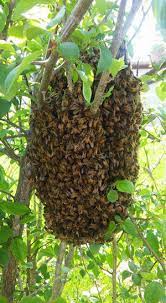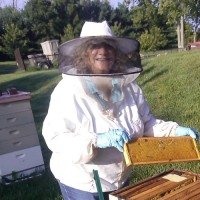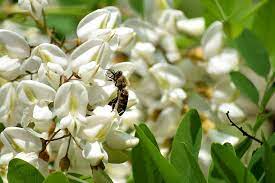
UNDATED – Kathleen Prough, Chief Apiary Inspector reports cool-weather may have slowed bee swarms down a little.

“This week is forecasted to be in the 70s with warmer nights than we have had for a while. With a couple of days of rain this week, bees will swarm for sure,” she added. “I hope beekeepers have their swarm traps out so they can catch some free bees. If the swarm is very large look for more than one queen.”

There are many reasons why honey bees swarm. It’s the natural method or reproduction or increase in population. Most of the time, it’s because a beekeeper’s hive is overcrowded and the queen has run out of space to lay eggs. She will stop laying eggs and shrink down in size so she can fly. When swarming, the queen takes off with part of population to start a new colony. The old colony will make a new queen and continue to prosper.
The swarm will fly away, land and cluster on a tree limb, brush or other location. The swarm cluster may be the size of a softball to larger than a basketball. Normally, this is not a permanent home and they usually move onto a preferred home such as a hollow tree.
Swarm season in Indiana is in May around Mother’s Day. Once in a while, there may be swarms in March and into September. This depends on the weather and the hive condition.
Swarms after July 1 are late swarms that may not make it through the winter unless the beekeeper does several things to get them strong enough for the winter.
A honey bees’ preferred home is a hollow tree where they will be protected from the cold weather. Once in a while, they will start a new home in an exposed tree limb. In this situation, you will see the exposed yellow beeswax comb that the bees will be clustering on. Sadly, they will not make it through Indiana’s winters. If you do see this comb and bees, contact a beekeeper.
Occasionally, a hollow tree with bees in it may need to be cut down. Contact a beekeeper to see if they are interested. Some beekeepers will come and get these bees.
Honey supers should be on hives. A honey super consists of a box in which 8–10 frames hung in a beehive that is used to collect honey. With nectar coming in since April, at least one honey super should already be on the hives. Now add two or more honey supers to be ready for the major nectar flow.
The autumn olive and bush honeysuckle are blooming.
“I’ve seen some sweet clover already blooming in central Indiana,” Prough said. “In the next couple of weeks, the black locust should be blooming in central Indiana. I hope to get some of that black locust nectar – it is prized honey.”

Prough said she talked to one beekeeper near Bedford who said the black locust was hit by the cold weather last week.
“He does not think he will get any black locust honey now,” she added. “That would be two years in a row for that area. Black locust nectar flow looks good in Central and Northern Indiana. The only thing to watch out for is severe rain keeping the bees in the hive while locust is in full bloom. I am staying positive that the weather will start warming up and stay warm.”
Information Kathleen Prough Chief Apiary Inspector – KPrough@dnr.IN.gov



